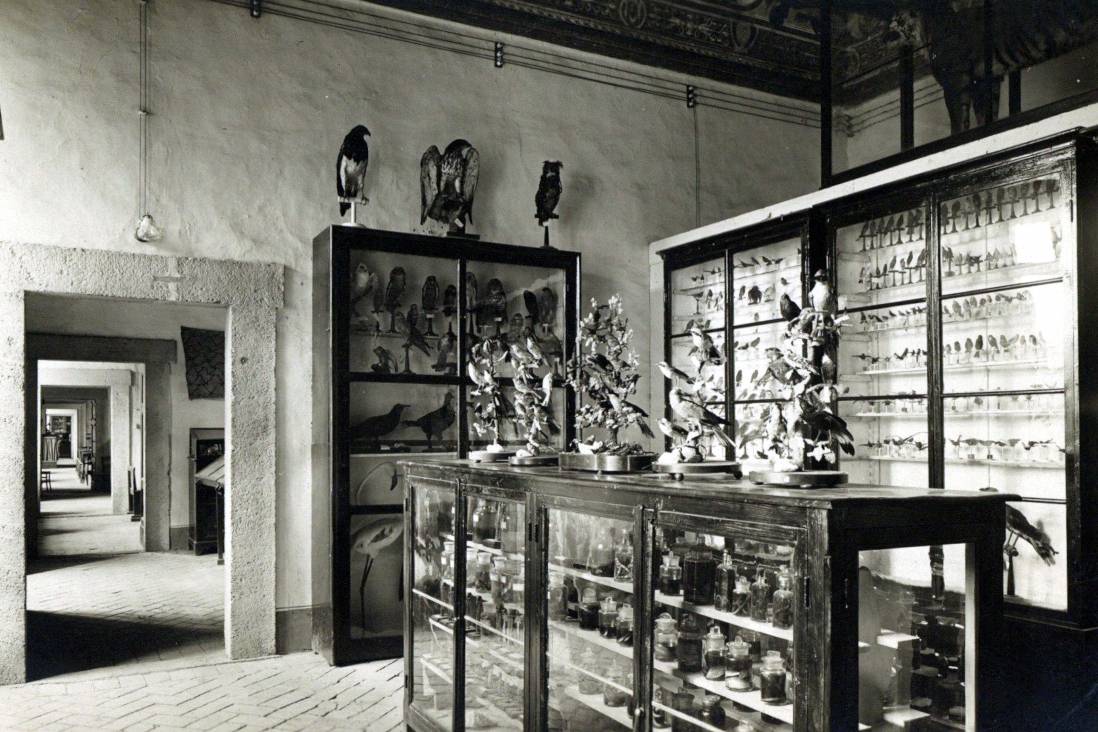Science labs in Jesuit colleges

In the colleges of the Society of Jesus, students were grappling with numerous subjects every day: Italian, history, geography, Latin, Greek. There was also no shortage of music and gymnastics. Between the nineteenth and twentieth centuries, in fact, boys played a variety of sports, from those initially more related to aristocratic circles, such as horseback riding and fencing, to soccer and athletics.
Collegians also learned, now so -called “STEM” subjects: math, science, and physics. Lessons were not only held in classrooms. In fact, Jesuit colleges also housed actual science labs or classrooms equipped for certain subjects at each institution.
The College of Villa Mondragone
At Villa Mondragone, on one of the highest floors of the college there was the so-called “Sala Ciampi”: a study room whose walls were frescoed with maps. In the following photo, we can see the map depicting Italy and the layout of the room with small tables for the boarders’ study after school lessons. The author of the drawings was Fr. Felice Ciampi, a Jesuit and teacher at the boarding school, after whom the room was named.

Also in the villa were stored, for a number of years, the instruments belonging to Fr. Angelo Secchi which the Jesuit used for his daily work at the Roman College Observatory. This was a veritable “Physics Cabinet.” It is unclear, however, whether these instruments were used by the students or only in storage.
However, the students also had at their disposal a whole and sizeable collection of stuffed animals. In the photograph accompanying today’s in-depth study, we see some of the many display cases that occupied several rooms in the college. Inside and on the cabinets are clearly visible: birds of all species, from sparrows to eagles to flamingos. There are also display cases housing butterflies and different kinds of insects.
Taxidermy, a practice no longer used today for educational purposes, in the past made it possible to preserve the bodies of animals, more or less rare, domestic and wild, to allow their study for future generations. Often objects from missions also ended up in these cabinets.
How many science and physics cabinets were active in our provinces?
It is difficult to say for sure; the surviving documentation is not sufficient to map them all, nor does it return complete and homogeneous information about their contents, function and personnel.
The College of Loreto
Secchi acts as a bridge, in a way, between the College of Loreto and the College of Nobles at Villa Mondragone. The deposit of his instruments at the Villa probably occurred following the forfeiture of the Collegio Romano, where the astronomical observatory he ran was located, after the taking of Rome. Secchi would die eight years later.
However, we can go back in time to 1841 to recount the setting up of another laboratory. We are in the College of Loreto, where Secchi taught physics between 1841 and 1844.
Among the papers of the College of Loreto we have no lists, inventories or photographs of scientific instruments, but it is here that Angelo Secchi combines teaching with his activity as a scientist.
The house diaries in fact tell us that shortly before his arrival, a teaching laboratory was set up. The Rector between June and July 1941 purchased a “pneumatic machine” from Paris and an “electric machine from Forli for the school of physics; thus the laboratory was opened.”
In September the first physics and mathematics recital was held.
Secchi carried out some experiments with his students. For example, the seda of September 28, 1842: “the first aerostatic globe was raised from the boarders of the first Camerata and by force of thrusts it flew happily.” The same experiment was repeated in October.
During the year Secchi organized several physics and mathematics essays, in the presence of the townspeople also making use of scientific machinery and instruments.
The Vida College
What remains today of these cabinets? Nothing, in terms of objects. In fact, the instruments and stuffed animals after a school closed were lost or donated to other institutions. In the case of the rich collection at Villa Mondragone, a part of it found its way to the Massimiliano Massimo Institute.
However, something of that collection also remains in the archives: photographs of them, inventories drawn up for a move or for the sale of the collection.
Such is the case with the science cabinet of the Vida College; in Cremona. We have no photos of the laboratory, however, in the Veneto – Milanese Province fund, correspondence is preserved with the Marquises Stanga, creators of the donation of the physics cabinet. The objects, for some years, were put in a museum. We also possess the inventory of the objects that made up the collection of the Cremona scientific cabinet.
Other colleges
There was at least one other physics cabinet, according to our inventories, within the Arici college in Brescia. Lists of objects and instruments and correspondence regarding its donation to the diocese, when the Society of Jesus sold the college, are preserved in the archives for this laboratory as well.
Further research could help us delve into the frequency with which laboratories were used and possibly map all those present in the five historic provinces.
Maria Macchi











